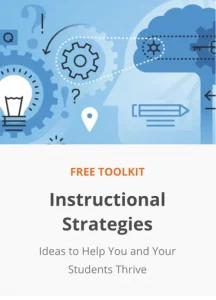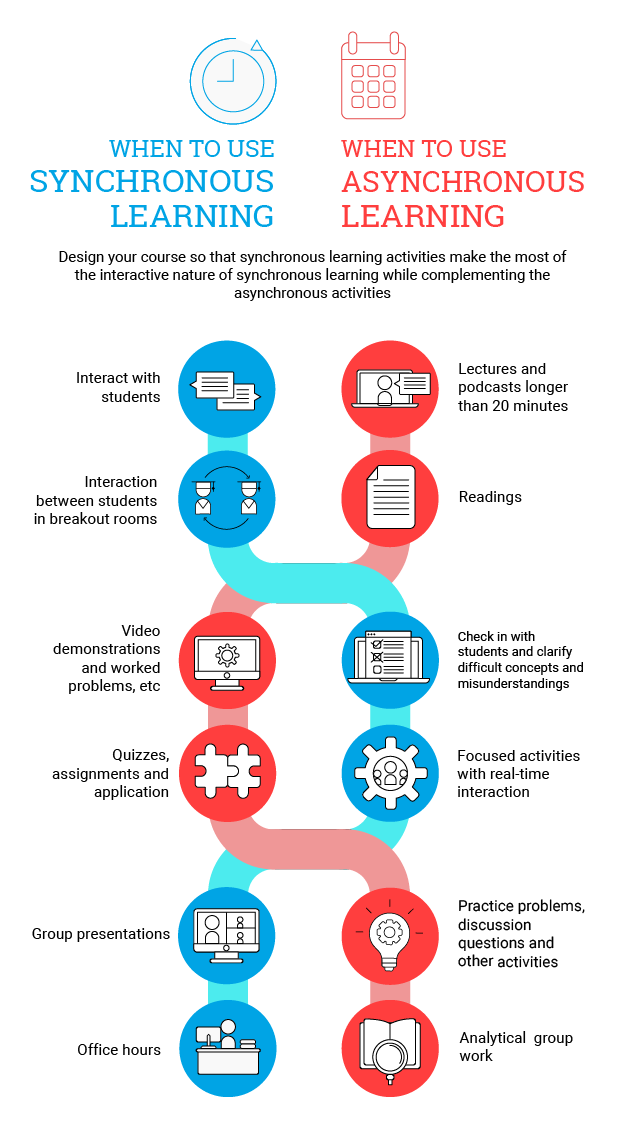In the age of online and blended learning, synchronous and asynchronous learning are terms we often hear where course content and teaching methods are concerned. The terms sound related, alike even, but what exactly do they mean, and what are the differences?
Synchronous and asynchronous learning are two different approaches to delivering learning content and interacting with students, and each has its own distinct advantages and disadvantages. Choosing one over the other comes down to what best serves the content and the students—very much like a business looking at the needs of its workers when choosing team working platforms such as 8×8 Voice for Teams.

Choosing synchronous or asynchronous learning demands proper consideration of the kind of communication the learning material and students require. The basic difference between the two is that synchronous learning happens simultaneously for all learners, and asynchronous learning is the opposite; each student can learn in their own time, on a schedule that differs from their classmates.
When deciding on the format of any online learning, it all comes down to communication. Educators must ask, does the subject matter require students to converse with each other? Will students have questions that need answering in real time? Could tools like small business VoIP phone systems be advantageous? Or can content largely be listened to, read, or watched at the learner’s own pace?
Let’s look at both approaches in more detail.
The Differences
 Before we look at the differences, it’s important to say that synchronous and asynchronous learning are not mutually exclusive; in fact, you can use them in conjunction to maximize the effectiveness of a course and give learners the best possible experience. It’s also true that both can form part of both online and offline education.
Before we look at the differences, it’s important to say that synchronous and asynchronous learning are not mutually exclusive; in fact, you can use them in conjunction to maximize the effectiveness of a course and give learners the best possible experience. It’s also true that both can form part of both online and offline education.
Synchronous Learning
The classroom learning scenario, whether it’s a virtual or physical classroom, is a useful way to visualize synchronous learning. Learners meet at the same time and are taught by a teacher or instructor in real time. To facilitate this remotely, a live-streamed online classroom might use chat rooms, video calls, or tools like student-wide and staff-wide communication with a VoIP phone system.
We’ll save you from Googling “What is VoIP caller?”: a VoIP caller is an individual who uses Voice over Internet Protocol (VoIP) technology to make telephone calls over the internet, rather than the traditional telephone network. VoIP helps synchronous learning by providing a platform for real-time communication and collaboration between students and teachers, allowing for interactive learning experiences through features such as video calls, chat rooms, and student-wide and staff-wide communication.
The live aspect of synchronous learning can also take the form of a webinar with breakout rooms, or a live event streamed on social media, with questions and answers and chat functions. But it can also be a one-to-one coaching session or tutorial over Zoom or another platform.
Crucially, as with a real-life classroom, a virtual classroom for remote learning must give students the opportunity to interact with each other as well as the teacher. For certain subjects, this is essential, and although there might be reading material or assignments set for the students to carry out at their own pace, the primary instruction will be a synchronized group event.

Asynchronous Learning
For certain types of study and some subjects, it’s more convenient for students to access tuition or learning materials at a time that suits them. This is the fundamental advantage of asynchronous learning.
Tutors post lectures, videos, and reading matter, and students can digest the content as and when they prefer. They can still ask questions and interact with classmates, but this will be on an individual basis at a time that works for them. Of course, there are still deadlines, and tutors set assignments, but there is much greater flexibility as the study timetable is not fixed to a date, time, or place.
This is particularly useful for students who are working while studying, in different time zones, or for certain subjects. For example, a student might be studying business and management essentials and have a large amount of content consisting of case studies and real-life examples to read or watch talks about. This is precisely the type of content that students can engage with at their own pace and in their own time.

The Advantages and Disadvantages: Synchronous Learning
Human beings are generally social animals, and while individuals differ in how much human contact they need, broadly speaking, we have evolved to work and learn together. Even in situations where we learn or work remotely, this connection with others is important. For this reason, even those who work partly from home want a great company culture with hybrid working.
The advantages of synchronous learning are that feedback, building rapport, correcting mistakes, and assessment can all happen in real time. This has benefits for both learners and educators.
A tutor can see straight away who is struggling or losing interest and who is responding well. Learners can ask questions and get immediate answers, as well as bond with and bounce ideas off their classmates. Educators often find it easier to engage with their students with asynchronous learning. This makes the job of getting to know students and later assessing them far easier.
But there are disadvantages, too. Some students struggle in a group environment, even a virtual one. Some can also feel under pressure for time when completing tasks and feel they have to compete with the rest of the group. Students who have busy lives can also end up missing classes because the timetable doesn’t suit their needs. In fact, the set time aspect of synchronous learning can be the least advantageous element of this form of education for many.

The Advantages and Disadvantages: Asynchronous Learning
Asynchronous learning offers a greater amount of flexibility for learners and educators. It can come in the form of many traditional teaching materials such as books, recordings, and course documents. You can also use more modern technology-based methods such as videos, websites, and online activities.
Another advantage of asynchronous learning is that it allows learners to take their time, study in private, mull over, and consider the content at their own pace. This is particularly useful for some subjects where opinions and viewpoints need to be reached, having examined source material, for example, with a topic such as issues and controversies in history.
It’s also a huge advantage for educational organizations wishing to scale their courses and offer education to large numbers of learners at a time. With students studying on their own timetable, courses can also bridge international time zones and national holidays.
But the disadvantages are clear. The camaraderie and momentum of people coming together at one time is absent, or at least harder to generate. Educators can also find their own workflow hard to gauge and control, with questions and requests for information from students coming in at random times.

Making the Right Choice
In choosing learning methods for a course or program, it’s really about deciding whether synchronous, asynchronous, or a blend of both best fits the bill.
For career and workplace skills, it’s more than likely that some element of asynchronous would be useful. After all, managing your own workload is a key part of the modern workplace; therefore, it makes sense to have students study at their own pace. But of course, synchronous learning would provide real-time study with other students, giving important opportunities for debate, the exchange of ideas, and real-time feedback.
The key consideration is to focus on the requirements of the content and the learners. Then tailor the course to their needs. Look at whether you’re targeting international students or people looking to upskill while they work. Or are you looking to teach a small local course that could fit a synchronous style of learning? Asking questions about the target audience will help you make the right decision.
For more on this topic, check out our FREE 2-part Asynchronous Learning Workshop!
See also:



